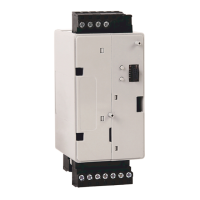Rockwell Automation Publication 193-UM015E-EN-P - October 2015 561
EtherNet/IP Communication Chapter 10
Determining Network
Parameters
To operate an EtherNet/IP network, you must define these parameters.
Table 562 - EtherNet/IP Network Parameters
If DNS addressing is used or if the module is referenced via a host name in an
MSG instruction, the following parameters must be defined.
Table 563 - EtherNet/IP Network Parameters for DNS Addressing
Network Parameter Description
IP Address The IP address uniquely identifies the module. The IP address
is in the form xxx.xxx.xxx.xxx where each xxx is a number from
0...255. Do not use the following IP addresses, as these are
reserved values:
• 0.0.0.1...0.255.255.255
• 127.0.0.0...127.255.255.255
• 224.255.255.255...255.255.255.255
Subnet Mask Subnet addressing is an extension of the IP address scheme
that allows a site to use one network ID for multiple physical
networks. Routing outside of the site continues by dividing
the IP address into a net ID and a host ID via the class. Inside
a site, the subnet mask is used to redivide the IP address into
a custom network ID portion and host ID portion.
NOTE: If you change the subnet mask of an already-
configured module, you must cycle power to the module for
the change to take effect.
Gateway A gateway connects individual physical networks into a
system of networks. When a node needs to communicate
with a node on another network, a gateway transfers the data
between the two networks.
Consult with your Ethernet network administrator to determine if these
parameters need to be specified.
Network Parameter Description
Host Name A host name is part of a text address that identifies the
module. The full text address of a module is:
host_name.domain_name.
Domain Name A domain name is part of a text address that identifies the
domain in which the module resides. The full text address of a
module is: host_name.domain_name. The domain name has a
48-character limit.
Primary DNS Server Address This identifies any DNS servers that are used in the network.
You must have a DNS server configured if you specify an
SMTP server with a name. The DNS server converts the
domain name or host name to an IP address that can be used
by the network.
For more information on DNS addressing, see page 570
.
Secondary DNS Server Address

